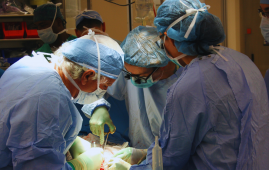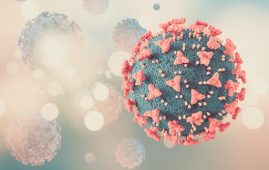

A loss of enzymatic processes within the body can increase a person’s risk of bone fracture. This new insight was recently published in eLife by an international team of scientists and engineers led by Deepak Vashishth, the director of the Center for Biotechnology and Interdisciplinary Studies (CBIS) at Rensselaer Polytechnic Institute.
Enzymatic processes are essential to any number of chemical reactions that occur within the body, including the production of the extracellular matrix within the bone that is critical for mechanical support. Phosphorylation — one of those key enzymatic processes — is the attachment of a phosphoryl to a protein, and is critical for cellular regulation. This process plays a role in many diseases, but until now, researchers didn’t know if it altered tissue integrity and organ function.
In this paper, researchers looked at a protein known as osteopontin, which plays a vital role in holding the matrix together. The researchers developed a process by which they could induce phosphorylation — or its counterpart, dephosphorylation — in bones from genetically modified mice, some that had osteopontin and others that did not. By comparing results from the two groups, researchers found that fracture toughness, a measure of bone’s mechanical strength, increased with osteopontin phosphorylation and declined with dephosphorylation. More specifically, phosphorylation enhanced crosslinks and increased the attraction between the charged groups on osteopontin and bone mineral, making the bone stronger and its fracture more difficult.
“This is the first study that lays down that phosphorylation in bone matters, particularly how it assists bone in releasing energy, and that loss of this modification is bad for bone,” Vashishth said.
The team also studied the effect of osteopontin phosphorylation levels in the rare bone diseases hypophosphatemia and hyperphosphatemia, which are associated with skeletal deformities. In both diseases, Vashishth said, osteopontin phosphorylation levels decreased, a finding that lays the groundwork for further exploration.
“Another promising discovery was that these levels do change with diseases in bone,” Vashishth said. “Is phosphorylation directly affecting the fracture propensity of bones in these diseased conditions? And what therapeutic tools can we use to fix this? These are the questions that we want to investigate.”
In the spirit of the New Polytechnic, the model that drives research and education at Rensselaer, this research was highly collaborative across multiple disciplines. Vashishth and his lab worked with researchers at McGill University in Canada, the University of Southampton in the United Kingdom, the University of Patras in Greece, Aarhus University in Denmark, and Vienna University of Technology in Austria. Each research team brought different expertise and piece of this puzzle to the work.
The team’s findings may also be applied to similar processes within other connective tissues and possible therapeutics to counteract abnormal osteopontin phosphorylation levels.
“This is not just specific to the bone, because phosphorylation is a more ubiquitous change in other tissues in the body,” Vashishth said. “Osteopontin is not only in bone, but it’s also in other tissues in our body, like our kidneys and several other places. This research can also shed light on other things that can happen throughout the body.”
more recommended stories
 Safer Allogeneic Stem Cell Transplants with Treg Therapy
Safer Allogeneic Stem Cell Transplants with Treg TherapyA new preclinical study from the.
 Autoimmune Disorders: ADA2 as a Therapeutic Target
Autoimmune Disorders: ADA2 as a Therapeutic TargetAdenosine deaminase 2 (ADA2) has emerged.
 Kaempferol: A Breakthrough in Allergy Management
Kaempferol: A Breakthrough in Allergy ManagementKaempferol, a dietary flavonoid found in.
 Early Milk Cereal Drinks May Spur Infant Weight Gain
Early Milk Cereal Drinks May Spur Infant Weight GainNew research published in Acta Paediatrica.
 TaVNS: A Breakthrough for Chronic Insomnia Treatment
TaVNS: A Breakthrough for Chronic Insomnia TreatmentA recent study conducted by the.
 First-of-Its-Kind Gene-Edited Pig Kidney: Towana’s New Life
First-of-Its-Kind Gene-Edited Pig Kidney: Towana’s New LifeSurgeons at NYU Langone Health have.
 Just-in-Time Training Improves Success & Patient Safety
Just-in-Time Training Improves Success & Patient SafetyA study published in The BMJ.
 ChatGPT Excels in Medical Summaries, Lacks Field-Specific Relevance
ChatGPT Excels in Medical Summaries, Lacks Field-Specific RelevanceIn a recent study published in.
 Study finds automated decision minimizes high-risk medicine combinations in ICU patients
Study finds automated decision minimizes high-risk medicine combinations in ICU patientsA multicenter study coordinated by Amsterdam.
 Study Discovers Connection Between Omicron Infection and Brain Structure Changes in Men
Study Discovers Connection Between Omicron Infection and Brain Structure Changes in MenA recent study in the JAMA.

Leave a Comment